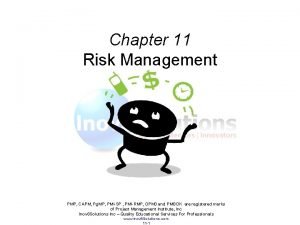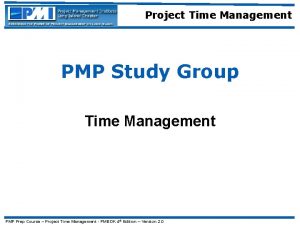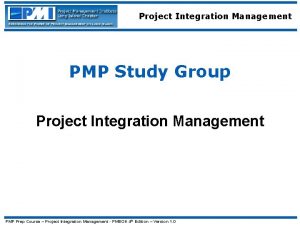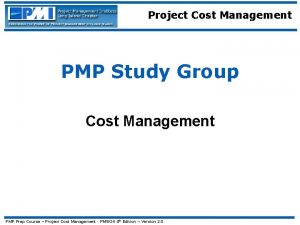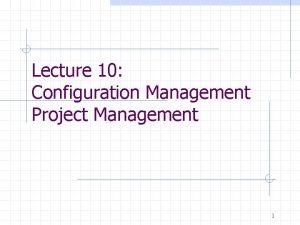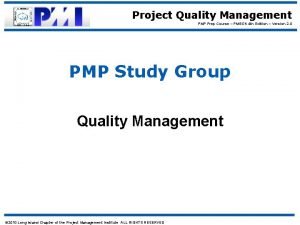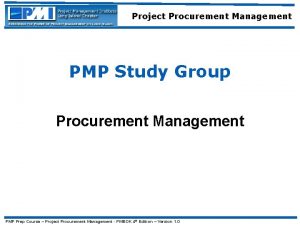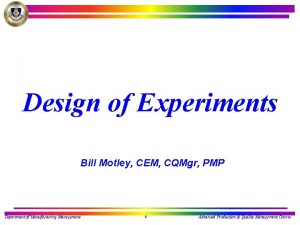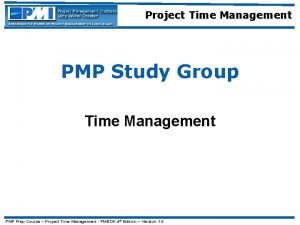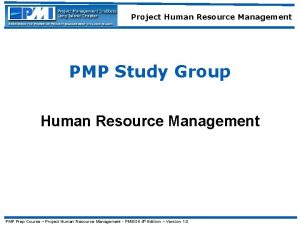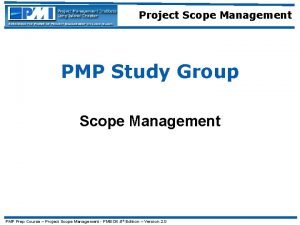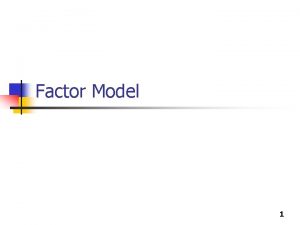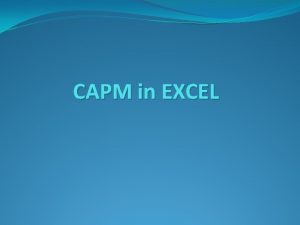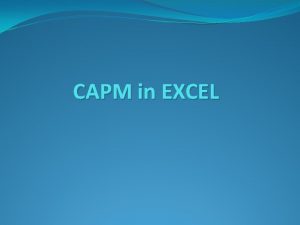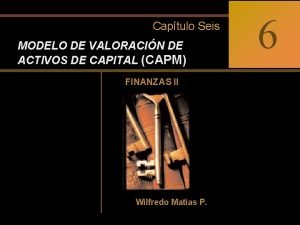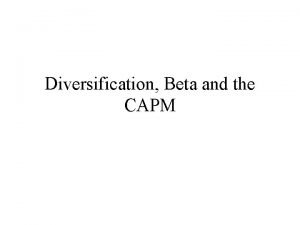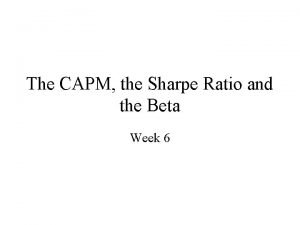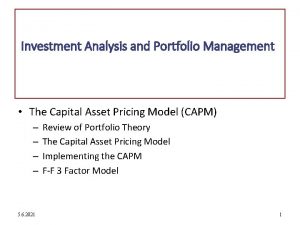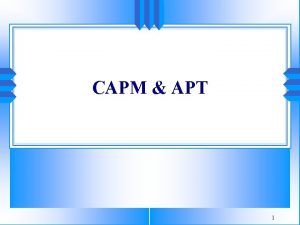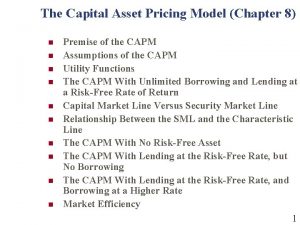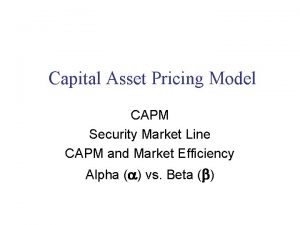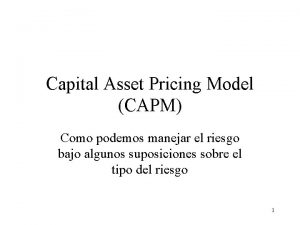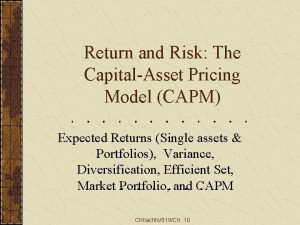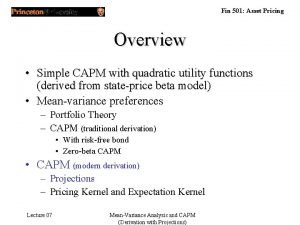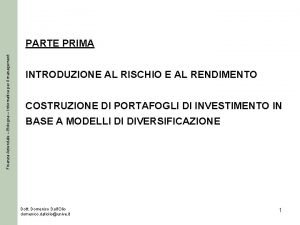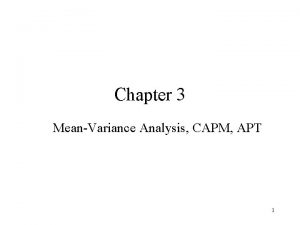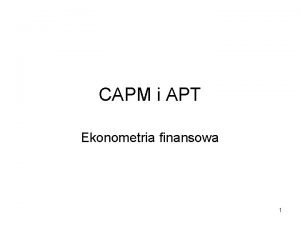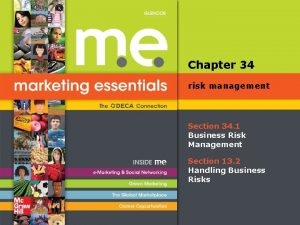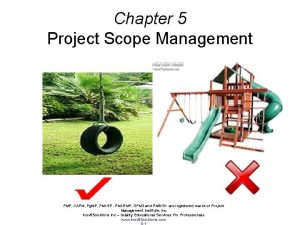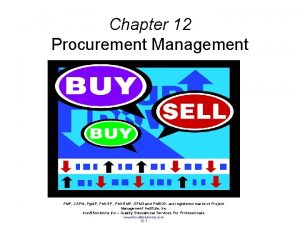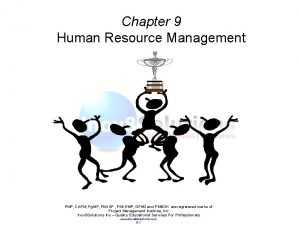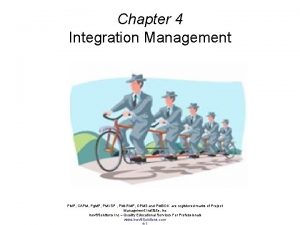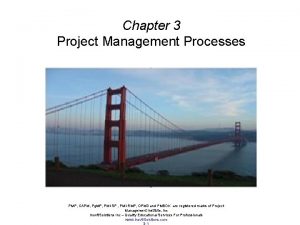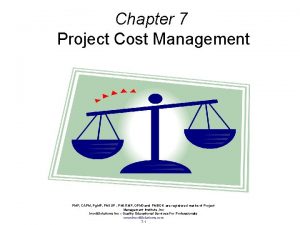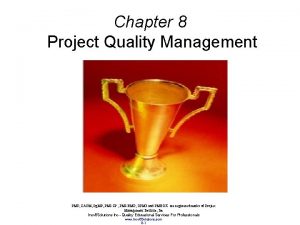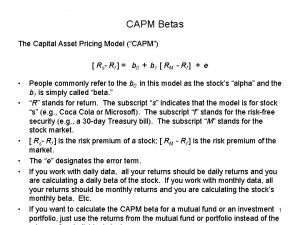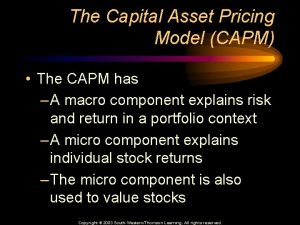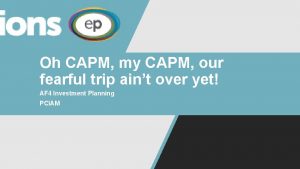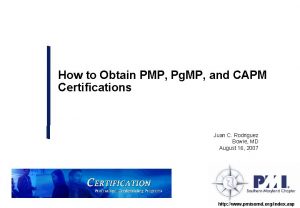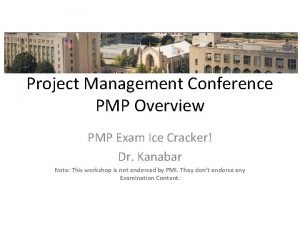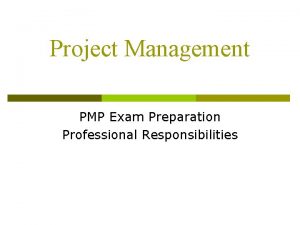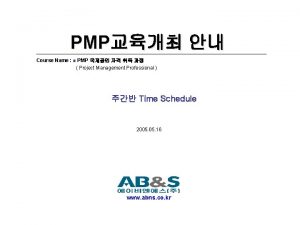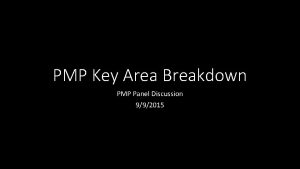Chapter 11 Risk Management PMP CAPM Pg MP


















































- Slides: 50

Chapter 11 Risk Management PMP, CAPM, Pg. MP, PMI-SP , PMI-RMP, OPM 3 and PMBOK are registered marks of Project Management Institute, Inc Inov 8 Solutions Inc – Quality Educational Services For Professionals www. Inov 8 Solutions. com 11 -1

Risk Management Contents • Risk Management Overview • Risk Management processes • Tools/techniques/methods utilized in each process PMP, CAPM, Pg. MP, PMI-SP , PMI-RMP, OPM 3 and PMBOK are registered marks of Project Management Institute, Inc Inov 8 Solutions Inc – Quality Educational Services For Professionals www. Inov 8 Solutions. com 11 -2

Risk Management Objectives By the end of this chapter, you should be able to: 1. Explain the importance of risk management on projects. 2. Name the Risk Management processes 3. Describe the tools and techniques used and activities involved in each process PMP, CAPM, Pg. MP, PMI-SP , PMI-RMP, OPM 3 and PMBOK are registered marks of Project Management Institute, Inc Inov 8 Solutions Inc – Quality Educational Services For Professionals www. Inov 8 Solutions. com 11 -3

Project Risk Management Processes 11. 1 – Plan Risk Management 11. 2 – Identify Risks 11. 3 – Perform Qualitative Risk analysis 11. 6 – Control Risks 11. 5 – Plan Risk Responses 11. 4 – Perform Quantitative Risk Analysis PMP, CAPM, Pg. MP, PMI-SP , PMI-RMP, OPM 3 and PMBOK are registered marks of Project Management Institute, Inc Inov 8 Solutions Inc – Quality Educational Services For Professionals www. Inov 8 Solutions. com 11 -4

Review Quiz Which one of the following is not a Risk Management process? A. B. C. D. Plan Risk Management Resolve Risks Perform Qualitative Risk Management Control Risks PMP, CAPM, Pg. MP, PMI-SP , PMI-RMP, OPM 3 and PMBOK are registered marks of Project Management Institute, Inc Inov 8 Solutions Inc – Quality Educational Services For Professionals www. Inov 8 Solutions. com 11 -5

Project Risk Management • What is a Risk? • Risk is the possibility of suffering loss, injury, disadvantage, or destruction. (Webster's Third New International Dictionary 1981) OR • An undesired event as a result of uncertainty, complexity, constraint, or lack of resources – something that can go wrong – Risk Characteristics • A risk may or may not happen. There is some probability of it occurring • If it is inevitable, it is not a risk • a risk has unwanted consequences • If there is no impact, its not a risk PMP, CAPM, Pg. MP, PMI-SP , PMI-RMP, OPM 3 and PMBOK are registered marks of Project Management Institute, Inc Inov 8 Solutions Inc – Quality Educational Services For Professionals www. Inov 8 Solutions. com 11 -6

Good Risk Management Practices • Be a good risk manager or you will become a good crisis manager (SITC) • If you don't actively attack the risks, they will actively attack you. (Tom Gilb) • Projects that don't manage risk are at risk (ICE Corp) • Risk management is not free; prepare to commit resources, define a risk management process, and make a risk reserve available. • Risk in itself is not bad; risk is essential to progress (Roger Van Scoy) PMP, CAPM, Pg. MP, PMI-SP , PMI-RMP, OPM 3 and PMBOK are registered marks of Project Management Institute, Inc Inov 8 Solutions Inc – Quality Educational Services For Professionals www. Inov 8 Solutions. com 11 -7

Project Risk Management Threats and Opportunities • A risk event is something that is identified in advance that may or may not happen. If it does not happen it can have a positive or negative effect on the project • A positive impact (good risks) risk is called “Opportunities”. • Up to 90 percent of threats that are identified and investigated in the risk management process can be eliminated. PMP, CAPM, Pg. MP, PMI-SP , PMI-RMP, OPM 3 and PMBOK are registered marks of Project Management Institute, Inc Inov 8 Solutions Inc – Quality Educational Services For Professionals www. Inov 8 Solutions. com 11 -8

Project Risk Management Risk Factors • The probability that it will occur (what) • The range of possible outcomes (impact) • When is it expected to happen (when) • The frequency at which it will happen (how often) Risk Averse • Someone who does not want to take risk (play it safe) PMP, CAPM, Pg. MP, PMI-SP , PMI-RMP, OPM 3 and PMBOK are registered marks of Project Management Institute, Inc Inov 8 Solutions Inc – Quality Educational Services For Professionals www. Inov 8 Solutions. com 11 -9

Project Risk Management Input to and output of Risk Management • Perform exercise on page 376, 377 on Rita’s book. PMP, CAPM, Pg. MP, PMI-SP , PMI-RMP, OPM 3 and PMBOK are registered marks of Project Management Institute, Inc Inov 8 Solutions Inc – Quality Educational Services For Professionals www. Inov 8 Solutions. com 11 -10

Plan Risk Management • • Deciding how to approach and plan the risk management activities for a project. Risk management Plan may include: – – – Methodology : Defines the approaches, tools and data sources that may be used to perform risk management on the project. Roles and Responsibilities : Defines the lead, support and risk management team membership for each type of action in the risk management plan. Budgeting : Establishes a budget for risk management for the project. Timing : Defines how often the risk management process will be performed throughout the project life cycle. Risk Categories : Risks could be internal, external, technical, and unforeseeable. Risk Probability and Impact : What’s the probability of a risk event happening and its related impact. Stakeholders Tolerance and thresholds : Stakeholders tolerance and thresholds criteria for risks that will be acted upon, by whom, and in what manner. Scoring and Interpretation: Scoring and interpretation method appropriate for the type and timing of the qualitative and quantitative risk analysis being performed. Reporting Formats: Describes the content and format of the risk response plan. Tracking : Documents how all the facets of risk activities will be recorded for the benefit of the current project, future needs and lessons learned. Types of Risks : Business risks (Risk of a gain or loss) and Pure (insurable) risks. i. e. only a risk of loss (i. e. fire, theft, personal injury, etc. ) PMP, CAPM, Pg. MP, PMI-SP , PMI-RMP, OPM 3 and PMBOK are registered marks of Project Management Institute, Inc Inov 8 Solutions Inc – Quality Educational Services For Professionals www. Inov 8 Solutions. com 11 -11

Plan Risk Management • Class Group Activity – 30 Minutes – Divide Class into 3 groups (3 to 4 students in each group) – Discuss and brainstorm the inputs/outputs – Present your inputs/outputs to the rest of the teams – Check and compare your inputs/outputs with PMBOK® Guide 5 th edition PMP, CAPM, Pg. MP, PMI-SP , PMI-RMP, OPM 3 and PMBOK are registered marks of Project Management Institute, Inc Inov 8 Solutions Inc – Quality Educational Services For Professionals www. Inov 8 Solutions. com 4 -12

Identify Risks • • Defined as “determining which risks might affect the project and documenting their characteristics” All stakeholders as well as experts from other parts of the company or outside the company may be involved in indentifying the risks. The core team will begin the process and then the other members will become involved , making risks identification an iterative process. Project Managers should start looking for risks as soon as possible. Risk Categories • • Technical, quality , or performance risks – such as reliance on unproven or complex technology, unrealistic performance goals, changes to the technology used or to the industry standards during the project. Project Management Risks – such as poor allocation of resources, inadequate quality of the project plan, poor use of the project management disciplines. Organizational risks – such as cost, time, and scope objectives that are internally inconsistent, lack of prioritization of the projects, inadequacy or interruption of funding, and resource conflicts with other projects in the organization. External Risks – such as shifting legal or regulatory environment, labor issues, changing owner priorities, weather related risks (earthquake, flooding etc) PMP, CAPM, Pg. MP, PMI-SP , PMI-RMP, OPM 3 and PMBOK are registered marks of Project Management Institute, Inc Inov 8 Solutions Inc – Quality Educational Services For Professionals www. Inov 8 Solutions. com 11 -13

Identify Risks • Class Group Activity – 30 Minutes – Divide Class into 3 groups (3 to 4 students in each group) – Discuss and brainstorm the inputs/outputs – Present your inputs/outputs to the rest of the teams – Check and compare your inputs/outputs with PMBOK® Guide 5 th edition PMP, CAPM, Pg. MP, PMI-SP , PMI-RMP, OPM 3 and PMBOK are registered marks of Project Management Institute, Inc Inov 8 Solutions Inc – Quality Educational Services For Professionals www. Inov 8 Solutions. com 4 -14

Risk Identification Tools and Techniques • Information Gathering Techniques: – Brainstorming- Usually done in a meeting where one idea helps generate another. – Delphi technique - Way to reach a consensus of experts on a subject. – Interviewing – Consists of a team or project manager interviewing an expert to identify risks on the project or a specific element of work. – Strengths, weaknesses, opportunities and threats (SWOT) Analysis – An analysis that looks at the project to identify its strengths etc and thereby identify risks. – Checklist Analysis – Checklist is used to help identify specific risks within each category. – Assumptions Analysis – Analyzing what assumptions have been made on the project which may help identity more risks. – Diagramming Techniques – Similar diagramming techniques can be used to identify risks as used in Quality Management. • Triggers: – Sometimes called risk symptoms or warning signs, are indications that a risk has occurred or is about to occur. Example: Missing a deadline on an activity on critical path means there is a chance that you will miss the project deadline. PMP, CAPM, Pg. MP, PMI-SP , PMI-RMP, OPM 3 and PMBOK are registered marks of Project Management Institute, Inc Inov 8 Solutions Inc – Quality Educational Services For Professionals www. Inov 8 Solutions. com 11 -15

Qualitative Risk Analysis • • Process of accessing the impact and likelihood of identified risks. Determine which risk events warrant a response. Document non-critical, or non-stop risks. Prioritizes risks according to their potential effect on project objectives. • Probability and Impact: – One of the ways to help rank risks is to analyze the probability of a risk occurring and the effect of the risk on the project. – Determine the probability of each risk occurring - usually in the form of taking and educated guess. (e. g. low, medium, high) – Determine the consequences of each risk occurring – also in the form of an educated guess. (low, medium, high) • Assumption Testing: – “What assumptions have been made? ” – Before the project manager can use the risk information collected, assumptions made must be identified. PMP, CAPM, Pg. MP, PMI-SP , PMI-RMP, OPM 3 and PMBOK are registered marks of Project Management Institute, Inc Inov 8 Solutions Inc – Quality Educational Services For Professionals www. Inov 8 Solutions. com 11 -16

Qualitative Risk Analysis • Class Group Activity – 30 Minutes – Divide Class into 3 groups (3 to 4 students in each group) – Discuss and brainstorm the inputs/outputs – Present your inputs/outputs to the rest of the teams – Check and compare your inputs/outputs with PMBOK® Guide 5 th edition PMP, CAPM, Pg. MP, PMI-SP , PMI-RMP, OPM 3 and PMBOK are registered marks of Project Management Institute, Inc Inov 8 Solutions Inc – Quality Educational Services For Professionals www. Inov 8 Solutions. com 4 -17

Quantitative Risk Analysis • Quantitative risk analysis process is to analyze numerically the probability of each risk and its consequences on project objectives. • Determine which risks warrant a response. • Determine the quantified probability of meeting project objectives e. g. “We only have an 80% chance of completing the project within 6 months. ” • Identify risks requiring most attention. • Create realistic and achievable cost, schedule or scope targets. • PMI suggests that quantitative method is preferable to qualification because it is less subjective and is a better approximations of actual probabilities and consequences. PMP, CAPM, Pg. MP, PMI-SP , PMI-RMP, OPM 3 and PMBOK are registered marks of Project Management Institute, Inc Inov 8 Solutions Inc – Quality Educational Services For Professionals www. Inov 8 Solutions. com 11 -18

Quantitative Risk Analysis • Class Group Activity – 30 Minutes – Divide Class into 3 groups (3 to 4 students in each group) – Discuss and brainstorm the inputs/outputs – Present your inputs/outputs to the rest of the teams – Check and compare your inputs/outputs with PMBOK® Guide 5 th edition PMP, CAPM, Pg. MP, PMI-SP , PMI-RMP, OPM 3 and PMBOK are registered marks of Project Management Institute, Inc Inov 8 Solutions Inc – Quality Educational Services For Professionals www. Inov 8 Solutions. com 4 -19

Qualitative Risk Analysis • Data Precision Ranking – “How well understood is the risk? ” – Before the project manager can use the risk information collected, they must also analyze the precision of the data – how good is the data? • Risk Rating Matrix: – In order to sort or rate risks so a determination can be made as to which risks will move on through the risk process, a risk rating matrix may be used. • Outputs from Qualitative Risk Analysis: – – – – Risk rating of the project. List of prioritized risks. List of risks created for additional analysis in risk quantification or risk response planning. Non-critical or non-stop risks documented for later revisit during risk monitoring and control. The project can be compared to the overall risks of other projects. The project could be selected, continued, or terminated. Resources could be moved between the projects. PMP, CAPM, Pg. MP, PMI-SP , PMI-RMP, OPM 3 and PMBOK are registered marks of Project Management Institute, Inc Inov 8 Solutions Inc – Quality Educational Services For Professionals www. Inov 8 Solutions. com 11 -20

Quantitative Risk Analysis • Decision Tree: – A decision tree takes into account future events in trying to make a decision today. – It calculates expected value (probability time consequences) in more complex situations than the expected value. – Perform exercise Rita’s Pg 389/390 PMP, CAPM, Pg. MP, PMI-SP , PMI-RMP, OPM 3 and PMBOK are registered marks of Project Management Institute, Inc Inov 8 Solutions Inc – Quality Educational Services For Professionals www. Inov 8 Solutions. com 11 -21

Quantitative Risk Analysis • Monte Carlo Simulation: – Evaluates the project and not the task. – Provides the probability of completing the project on any specific day, or any specific account of cost. – Provides the probability of any task actually being on the critical path. – Provides a percent probability that each task will be on the critical path. – Translates uncertainties into impacts to the total project. – Can be sue to assess cost and schedule impacts. – Is usually done with a computer-based Monte Carol program. – Results in a probability distribution. • Outputs from Quantitative Risk Analysis: – – – Prioritized list of quantified risks Forecasts of potential project costs or schedule. Listing of the possible project completion dates and costs with their confidence levels. Probability of achieving the required project cost or schedules objectives. Documented list of not-critical, not-top risks. PMP, CAPM, Pg. MP, PMI-SP , PMI-RMP, OPM 3 and PMBOK are registered marks of Project Management Institute, Inc Inov 8 Solutions Inc – Quality Educational Services For Professionals www. Inov 8 Solutions. com 11 -22

Review Question Joe joined as a project manager in an organization where his manager asks him to analysis of risks for project giving a draft charter. What should help Joe best in this situation? A. A website for PM network B. Enterprise environmental factor C. Resource plan from project planning D. Lesson learns document from the previous project that failed earlier PMP, CAPM, Pg. MP, PMI-SP , PMI-RMP, OPM 3 and PMBOK are registered marks of Project Management Institute, Inc Inov 8 Solutions Inc – Quality Educational Services For Professionals www. Inov 8 Solutions. com

Review Question An output of Risk Identification is: A. A risk register. B. Expected monetary value of the risk events. C. Corrective actions. D. The plan for mitigation. PMP, CAPM, Pg. MP, PMI-SP , PMI-RMP, OPM 3 and PMBOK are registered marks of Project Management Institute, Inc Inov 8 Solutions Inc – Quality Educational Services For Professionals www. Inov 8 Solutions. com

Review Question A thorough review of _______will help identify potential risks to the project. A. Risk identification checklists based on historical information and knowledge B. The project’s change control system C. The project’s mission statement D. The project’s budget PMP, CAPM, Pg. MP, PMI-SP , PMI-RMP, OPM 3 and PMBOK are registered marks of Project Management Institute, Inc Inov 8 Solutions Inc – Quality Educational Services For Professionals www. Inov 8 Solutions. com

Review Question As an output of Quantitative Risk Analysis, the risk register is updated. These updates include: A. Prioritized list of quantified risks B. Probabilistic analysis of the threats to ignore and opportunities to accept C. Checklists, corrective actions, and quantified decision trees D. Direction, resources, and costs PMP, CAPM, Pg. MP, PMI-SP , PMI-RMP, OPM 3 and PMBOK are registered marks of Project Management Institute, Inc Inov 8 Solutions Inc – Quality Educational Services For Professionals www. Inov 8 Solutions. com

Review Question The Delphi technique has all of the following characteristics EXCEPT: A. It is a way to reach a consensus of experts on a subject such as project risk. B. It is a technique in which project risk experts participate anonymously. C. It helps reduce bias in the data and keeps any one person from having undue influence on the outcome. D. It is an ancient Greek technique to ensure that actions of subordinates are aligned with the vision of senior executives. PMP, CAPM, Pg. MP, PMI-SP , PMI-RMP, OPM 3 and PMBOK are registered marks of Project Management Institute, Inc Inov 8 Solutions Inc – Quality Educational Services For Professionals www. Inov 8 Solutions. com

Risk Response Planning • Involves finding out ”What are we going to do about it” • It involves finding ways to make the negative risk smaller or eliminate it, as well as finding ways to make positive risks more likely or greater in impact. • Strategies are agreed upon by all parties. • Primary and backup strategies are selected. • Risks are assigned to individuals or group to take responsibilities. • Risk Owner: – Each risk must be assigned to someone who will help develop the risk response and who will be assigned to carry it out or “own” the risk. – The risk owner is then free to take predetermined action when risks occur resulting in faster action, and less cost, time and other impacts on the project. PMP, CAPM, Pg. MP, PMI-SP , PMI-RMP, OPM 3 and PMBOK are registered marks of Project Management Institute, Inc Inov 8 Solutions Inc – Quality Educational Services For Professionals www. Inov 8 Solutions. com 11 -28

Risk Response Planning • Class Group Activity – 30 Minutes – Divide Class into 3 groups (3 to 4 students in each group) – Discuss and brainstorm the inputs/outputs – Present your inputs/outputs to the rest of the teams – Check and compare your inputs/outputs with PMBOK® Guide 5 th edition PMP, CAPM, Pg. MP, PMI-SP , PMI-RMP, OPM 3 and PMBOK are registered marks of Project Management Institute, Inc Inov 8 Solutions Inc – Quality Educational Services For Professionals www. Inov 8 Solutions. com 4 -29

Risk Response Planning • Risk Response Strategies: – Developing options and determining actions to enhance opportunities and reduce threats. • • • Avoidance : Changing the project plan to eliminate the risk or condition or to protect objective from its impact. Mitigation : Reduce the probability or the consequences of an adverse risk and increase the probability or consequences of an opportunity. Acceptance : Do nothing and say. “If it happens”. Active acceptance may include developing a contingency plan to execute, should a risk occur. Passive acceptance requires no action, leaving the project team to deal with the risks as they occur. Transference : Risk transference is seeking to shift the consequence of a risk to a third party together with ownership of the response. Transferring the risk simply gives another party responsibility for its management, it does not eliminate it. For e. g. purchasing of insurance, warranties, guarantees, or outsourcing the work. Perform exercise Rita’s pg 394 When Selecting risk strategies, it is important to remember: – Strategies must be timely. – The effort selected must be appropriate to the severity of the risk – avoid spending more money preventing the risk than the impact of the risk would cost if it occurred. – One response can be used to address more than one risk. – Involve the team, stakeholders, and experts in selecting a strategy. PMP, CAPM, Pg. MP, PMI-SP , PMI-RMP, OPM 3 and PMBOK are registered marks of Project Management Institute, Inc Inov 8 Solutions Inc – Quality Educational Services For Professionals www. Inov 8 Solutions. com 11 -30

Review Quiz Which one of the following is not a risk response strategy? A. B. C. D. Avoidance Acceptance Rejection Mitigation PMP, CAPM, Pg. MP, PMI-SP , PMI-RMP, OPM 3 and PMBOK are registered marks of Project Management Institute, Inc Inov 8 Solutions Inc – Quality Educational Services For Professionals www. Inov 8 Solutions. com 11 -31

Risk Response Planning Outputs from Risk Response • Planning: Developing options and determining actions to enhance opportunities and reduce threats. – Residual Risks : Are those that remain after avoidance, transfer or mitigation responses have been taken. – Secondary Risks : Arise as a direct result of implementing a risk response. – Contingency Planning : Planning the specific actions that will be taken if a risk event occurs or planned response. – Fallback Planning : Specific actions that will be taken if the contingency plan is not effective. – Risk Response Plan : A written document that captures the risks you identified and what you plan to do about them. The project manager should also record non-critical risks so that they can easily be revisited during the executed phase. – Revised Project Plan : The efforts spent in risk management will result in changes to the project plan. Tasks could be added, removed, or assigned to different resources. – Reserves : Formulating the amount of time or cost that needs to be added to the project to account for risk. PMP, CAPM, Pg. MP, PMI-SP , PMI-RMP, OPM 3 and PMBOK are registered marks of Project Management Institute, Inc Inov 8 Solutions Inc – Quality Educational Services For Professionals www. Inov 8 Solutions. com 11 -32

Review Quiz A secondary risk is defined as: A. The second risk that occurs on the project B. A risk that occurs as a result of implementing a risk response C. An unforeseen risk D. An expected risk PMP, CAPM, Pg. MP, PMI-SP , PMI-RMP, OPM 3 and PMBOK are registered marks of Project Management Institute, Inc Inov 8 Solutions Inc – Quality Educational Services For Professionals www. Inov 8 Solutions. com 11 -33

Control Risks • • • • • Keeping track of the identified risks Implementing risk responses Looking for the occurrence of risk triggers Monitoring residual risks Identifying new risks Ensuring the execution of risk plans. Evaluating the effectiveness of risk plans. Developing new risk responses. Communicating risk status and collecting risk status. Communicating with stakeholders about risks. Determining if assumptions are still valid. Revisiting low ranking or non-critical risks to see if risk responses need to be determined. Taking corrective action to adjust to the severity of actual risk events. Looking for any unexpected effects or consequences of risk events. Reevaluating risk identification, qualification, and quantification when the project deviates from the baseline. Updating risk plans Making changes to the project plan when new risk responses are developed. Creating a database of risk data that may be used throughout the organization on other projects. PMP, CAPM, Pg. MP, PMI-SP , PMI-RMP, OPM 3 and PMBOK are registered marks of Project Management Institute, Inc Inov 8 Solutions Inc – Quality Educational Services For Professionals www. Inov 8 Solutions. com 11 -34

Control Risks • Class Group Activity – 30 Minutes – Divide Class into 3 groups (3 to 4 students in each group) – Discuss and brainstorm the inputs/outputs – Present your inputs/outputs to the rest of the teams – Check and compare your inputs/outputs with PMBOK® Guide 5 th edition PMP, CAPM, Pg. MP, PMI-SP , PMI-RMP, OPM 3 and PMBOK are registered marks of Project Management Institute, Inc Inov 8 Solutions Inc – Quality Educational Services For Professionals www. Inov 8 Solutions. com 4 -35

Control Risks • Risk Response Audits: – Examining and documenting the effectiveness of the risk response and the person managing the risk. This is an important step in order to see if the plans put in place are effective and if changes are needed. • Risk Reviews: – Team needs to periodically review risk plans and adjust as required. Risk should be a major topic at team meetings to keep focus on risks and to make sure plans remain appropriate. • Outputs from Risk Monitoring and Control: – Workarounds: Unplanned responses to risks or dealing with risks that you could not or did not anticipate. – Corrective action: consists of performing the contingency plans or workaround. – Changes to the Project: Implementing contingency plans or workarounds frequently results in a requirement to change the project plan to respond to risks. – Updates to risk response plan: It is wise to always re-evaluate whether the plans need any correcting or adjusting after each unidentified ir identified risk occurs. – Risk Database: A repository that provides for collection, maintenance and analysis of data gathered and used in the risk management process. PMP, CAPM, Pg. MP, PMI-SP , PMI-RMP, OPM 3 and PMBOK are registered marks of Project Management Institute, Inc Inov 8 Solutions Inc – Quality Educational Services For Professionals www. Inov 8 Solutions. com 11 -36

Chapter Summary • Risk Management Overview • Risk Management processes • • • Plan Risk Management Identify Risks Perform Qualitative Risk Analysis Perform Quantitative Risk Analysis Plan Risk Responses Control Risks • Tools and Techniques utilized in each process PMP, CAPM, Pg. MP, PMI-SP , PMI-RMP, OPM 3 and PMBOK are registered marks of Project Management Institute, Inc Inov 8 Solutions Inc – Quality Educational Services For Professionals www. Inov 8 Solutions. com 11 -37

End of Chapter Quiz Question 1: After planning for all risks, the team concludes that one risk is unavoidable. This risk can be categorized as: A. B. C. D. Inevitable risk Unplanned risk Remaining risk Residual risk PMP, CAPM, Pg. MP, PMI-SP , PMI-RMP, OPM 3 and PMBOK are registered marks of Project Management Institute, Inc Inov 8 Solutions Inc – Quality Educational Services For Professionals www. Inov 8 Solutions. com 11 -38

End of Chapter Quiz Question 2: One team member informs you that he will miss a critical deadline. From a risk management perspective, this is an example of: A. B. C. D. Qualitative risk analysis Unplanned risk Risk Planning Risk trigger PMP, CAPM, Pg. MP, PMI-SP , PMI-RMP, OPM 3 and PMBOK are registered marks of Project Management Institute, Inc Inov 8 Solutions Inc – Quality Educational Services For Professionals www. Inov 8 Solutions. com 11 -39

End of Chapter Quiz Question 3: Although junior programmers outnumber seniors programmers on the development team, you decide to use a senior programmer due to the risk of using an inexperienced programmer on a complex, high profile project. This is an example of: A. B. C. D. Risk tolerance Risk avoidance Risk planning Risk strategy PMP, CAPM, Pg. MP, PMI-SP , PMI-RMP, OPM 3 and PMBOK are registered marks of Project Management Institute, Inc Inov 8 Solutions Inc – Quality Educational Services For Professionals www. Inov 8 Solutions. com 11 -40

End of Chapter Quiz Question 4: A list of prioritized risks is an output of which process? A. B. C. D. Perform Qualitative Risk Analysis Perform Quantitative Risk Analysis Risk Response Planning Control Risks PMP, CAPM, Pg. MP, PMI-SP , PMI-RMP, OPM 3 and PMBOK are registered marks of Project Management Institute, Inc Inov 8 Solutions Inc – Quality Educational Services For Professionals www. Inov 8 Solutions. com 11 -41

End of Chapter Quiz Question 5: The project team is in a meeting on risk identification. All the team members are offering ideas that are being written on the board. One idea leads to another idea. This technique is known as: A. B. C. D. Affinity diagrams Delphi technique Brainstorming Interviewing PMP, CAPM, Pg. MP, PMI-SP , PMI-RMP, OPM 3 and PMBOK are registered marks of Project Management Institute, Inc Inov 8 Solutions Inc – Quality Educational Services For Professionals www. Inov 8 Solutions. com 11 -42

End of Chapter Quiz Question 6: What would project manager do when he receives a request for a change in the project that increases project risk? A. Call the team and analyses the impact B. Discuss with the customer about the impact of change C. Use senility analysis of the risk with the team D. Add expected monetary value of the risk PMP, CAPM, Pg. MP, PMI-SP , PMI-RMP, OPM 3 and PMBOK are registered marks of Project Management Institute, Inc Inov 8 Solutions Inc – Quality Educational Services For Professionals www. Inov 8 Solutions. com 11 -43

End of Chapter Quiz Question 6: 2. Which of the strategies are for negative risks? A. Avoid, Mitigate, Transfer, Accept B. Avoid, Transfer, Mitigate C. Avoid, Transfer, Exploit, Mitigate D. None of the above Answer: A PMP, CAPM, Pg. MP, PMI-SP , PMI-RMP, OPM 3 and PMBOK are registered marks of Project Management Institute, Inc Inov 8 Solutions Inc – Quality Educational Services For Professionals www. Inov 8 Solutions. com 11 -44

End of Chapter Quiz Question 7: Which of the strategies are for negative risks? A. Avoid, Mitigate, Transfer, Accept B. Avoid, Transfer, Mitigate C. Avoid, Transfer, Exploit, Mitigate D. None of the above PMP, CAPM, Pg. MP, PMI-SP , PMI-RMP, OPM 3 and PMBOK are registered marks of Project Management Institute, Inc Inov 8 Solutions Inc – Quality Educational Services For Professionals www. Inov 8 Solutions. com 11 -45

End of Chapter Quiz Question 8: To be successful, the organization should be committed to addressing the management of risk: A. Just before a meeting with a client B. Proactively and consistently throughout the project C. As soon as time and cost estimates are ready D. Early in the execution phase PMP, CAPM, Pg. MP, PMI-SP , PMI-RMP, OPM 3 and PMBOK are registered marks of Project Management Institute, Inc Inov 8 Solutions Inc – Quality Educational Services For Professionals www. Inov 8 Solutions. com 11 -46

End of Chapter Quiz Question 9: Outputs from Risk Response Planning include all of the following EXCEPT: A. Risk register updates B. Corrective actions C. Risk-related contractual agreements D. Project management plan updates PMP, CAPM, Pg. MP, PMI-SP , PMI-RMP, OPM 3 and PMBOK are registered marks of Project Management Institute, Inc Inov 8 Solutions Inc – Quality Educational Services For Professionals www. Inov 8 Solutions. com 11 -47

End of Chapter Quiz Question 10: The outputs from risk monitoring and control include all of the following EXCEPT: A. Requested changes B. Work breakdown structure (WBS) C. Recommended corrective actions D. Updates to the risk register. PMP, CAPM, Pg. MP, PMI-SP , PMI-RMP, OPM 3 and PMBOK are registered marks of Project Management Institute, Inc Inov 8 Solutions Inc – Quality Educational Services For Professionals www. Inov 8 Solutions. com 11 -48

End of Chapter Quiz Question 11: Decision tree analysis has all of the following characteristics EXCEPT: A. It is usually structured using a decision tree diagram that describes a situation under consideration, and the implications of each of the available choices and possible scenarios. B. It incorporates the cost of each available choice, the probabilities of each possible scenario, and the rewards of each alternative logical path. C. It is primarily a descriptive technique and cannot be effectively used in quantitative risk analysis. D. Solving the decision tree provides the expected monetary value for each alternative, when all the rewards and subsequent decisions are quantified. PMP, CAPM, Pg. MP, PMI-SP , PMI-RMP, OPM 3 and PMBOK are registered marks of Project Management Institute, Inc Inov 8 Solutions Inc – Quality Educational Services For Professionals www. Inov 8 Solutions. com 11 -49

End of Chapter Quiz Question 12: Expected monetary value (EMV) analysis has all of the following characteristics EXCEPT: A. It is a statistical concept that calculates the average outcome when the future includes scenarios that may or may not happen. B. The EMV of opportunities will generally be expressed as positive values, while those of risks will be negative. C. EMV analysis cannot be used effectively in decision tree analysis. D. EMV is calculated by multiplying the value of each possible outcome by its probability of occurrence, and adding them together. PMP, CAPM, Pg. MP, PMI-SP , PMI-RMP, OPM 3 and PMBOK are registered marks of Project Management Institute, Inc Inov 8 Solutions Inc – Quality Educational Services For Professionals www. Inov 8 Solutions. com 11 -50
 Residual risk and secondary risk pmp
Residual risk and secondary risk pmp Theorie capital asset pricing model
Theorie capital asset pricing model Market risk credit risk operational risk
Market risk credit risk operational risk Pmp secondary risk
Pmp secondary risk Key risk indicators template
Key risk indicators template Risk map risk management
Risk map risk management Time management pmp
Time management pmp Project quality management pmp
Project quality management pmp Project integration management example
Project integration management example Project cost management pmp
Project cost management pmp Configuration management in project management
Configuration management in project management Quality management pmp
Quality management pmp Procurement management pmp
Procurement management pmp Project human resource management pmbok ppt
Project human resource management pmbok ppt Design of experiments pmp example
Design of experiments pmp example Time management pmp
Time management pmp Human resource management plan pmp
Human resource management plan pmp Product scope vs project scope
Product scope vs project scope Capm modell
Capm modell Portfolio diversification eliminates
Portfolio diversification eliminates Capm assumptions
Capm assumptions Jensen alpha ratio
Jensen alpha ratio Discount rate capm
Discount rate capm Factor models
Factor models Discount rate capm
Discount rate capm Expected rate of return capm
Expected rate of return capm Formula capm excel
Formula capm excel Capital asset pricing model excel
Capital asset pricing model excel Introduction to capm
Introduction to capm Capm finanzas
Capm finanzas Beta formula capm
Beta formula capm Sharpe ratio beta
Sharpe ratio beta The capm predicts the relationship between _______.
The capm predicts the relationship between _______. Apt and capm
Apt and capm Capm assumptions
Capm assumptions Cml vs sml
Cml vs sml Wacc capm
Wacc capm Capm
Capm Limitations of capm
Limitations of capm Security market line alpha
Security market line alpha Capm interpretacion
Capm interpretacion Capm
Capm 501
501 Capm damodaran
Capm damodaran Analiza portfelowa
Analiza portfelowa Informatica per il management bologna
Informatica per il management bologna Capm derivation
Capm derivation Capm apt
Capm apt Capm critique
Capm critique Financial management chapter 8 risk and return
Financial management chapter 8 risk and return Chapter 34 risk management worksheet answers
Chapter 34 risk management worksheet answers



